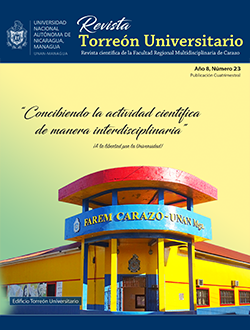Removal of hexavalent chromium in contaminated water using banana peel (Paradisiac musea) as adsorbent
DOI:
https://doi.org/10.5377/torreon.v8i23.9534Keywords:
hexavalent chromium, biomass, isothermal models, removal, adsorptionAbstract
This research aimed to remove the hexavalent chromium from contaminated water using the banana peel as an adsorbent. The study was realized in two stages: in the first stage, it worked with 1 g of the biomass at a particle size of approximately 600 µm, 5 minutes of contacts, 20 mg.l-1 of hexavalent chromium and at pH 3, 3,5, 5 and 7. In the second stage, it worked with the mass and time conditions at pH 3 and 3.5, increasing the metal concentration from 20 to 40 and 80 mg.l-1. The results obtained show that increasing the pH reduces the removal percentage and the adsorption capacity, however, at pH 3 and 3,5 the biomass removes almost 100% of the hexavalent chromium and increasing the concentration increases the adsorption capacity of the banana peel. The experimental data fit more to the Langmuir model than to the Freundlich model, which shows monolayer adsorption of a homogeneous surface. Also, the separation factor RL was between 0,809 and 0,383 which indicated favorable adsorption of the heavy metal in the biomass. The banana peel has great potential as an adsorbent for the removal of hexavalent chromium in water.
Downloads
1789
PDF 337
HTML (Español (España)) 2703
HTML 237
References
Al-Azzawi, M.N.A., Shartooh, S.M., Al-Hiyaly S.A.K. (2013). The Removal of Zinc, Chromium and Nickel from Industerial Waste-Water Using Banana Peels. Iraqi Journal of Science, 72-81.
Kamsonlian, S., Suresh, S., Majumder, C.B., Chand, S. (2011). CHARACTERIZATION OF BANANA AND ORANGE PEELS: BIOSORPTION MECHANISM. International Journal of Science Technology & Management, 1-7.
Abbasi, Z. Alikarami, M., Nezhad, E. R., Moradi, F. Moradi, V. (2013). Adsorptive Removal of Co2+ and Ni2+ by Peels of Banana from Aqueous Solution. Universal Journal of Chemistry , 90-95.
APHA, AWWA, WEF. (2012). Standard Methods for the Examination of Water and Wastewater. 22nd ed. En 3500-Cr B. Colorimetric Method (págs. 69-70). Washington: American Public Health Association.
Asamblea Nacional. (30 de 11 de 2017). DECRETO EJECUTIVO N°. 21-2017. LA GACETA- DIARIO OFICIAL, pág. 48.
Ashraf, A., Khalid S. b., Fazal, M. (2016). Removal of chromium (VI) from aqueous medium using chemically modified banana peels as efficient low-cost adsorbent. Elsevier, 1-10.
B. Meroufel, O. Benali, M. Benyahia . (2013). Adsorptive removal of anionic dye from aqueous solutions by Algeriankaolin: Characteristics, isotherm, kinetic and thermodynamic studies. J. Mater. Environ. Sci., 482-491.
Deshmukh, P. D., Khadse, G.K., Shinde, V. M., Labhasetwar, P. (2017). Cadmium Removal from Aqueous Solutions Using Dried Banana Peels as An Adsorbent: Kinetics and Equilibrium Modeling. Journal of Bioremediation & Biodegradation, 8: 395. doi: 10.4172/2155-6199.1000395.
Díaz, M. R., Contreras, R., Guardiola, M. A., Mayo del Río, C. (2016). Kinetic study of absorption of chromium (VI) using Canary Bananas Peels in contaminated water. International Journal of Innovation and Scientific Research, 139-145.
EPA. (January de 2000). Chromium Compounds. Obtenido de https://www.epa.gov/sites/production/files/2016-09/documents/chromium-compounds.pdf
Guertin J. (2004). Toxicity and Health Effects of Chromium (All Oxidation States). Chromium (VI) Handbook, 215-234.
Kumar,M., Majumder, C. B. (2014). Bio-absorptive Removal of Cr (VI) from Stimulated Tannery Waste Water using Different Adsorbents and Compare with GAC. Krishi Sanskriti, 73-86.
M. Romero-Sevilla, S. Sánchez-Cuadra, M. Benavente Silva. (2018). APLICACIÓN DE QUITOSANO MODIFICADO EN EL TRATAMIENTODE AGUAS RESIDUALES DE TENERÍAS. Nexo Revista Científica, 104-119.
Memon, J. R., Memon, S. Q., Bhanger, M. I., Khuhawar, M. Y. (2009). Banana Peel: A Green and Economical Sorbent for Cr(III) Removal. Pak. J. Anal. Environ. Chem, 20-25.
OSHA . (2009). Hexavalent Chromium. Washington.
Torres, L. , Cárdenas, J. F., Moctezuma, M. G., Martínez, V. M., Acosta, I. (2012). Remoción de cromo hexavante por la cáscara de plántano (Musa cavendishii). QUÍMICA HOY CHEMESTRY SCIENCES, 29-32.
Downloads
Published
How to Cite
Issue
Section
License
Los autores que publican en esta revista están de acuerdo con los siguientes términos.
- El autor o los autores de los artículos, ensayos o investigaciones conceden a la Universidad Nacional Autónoma de Nicaragua, Managua (UNAN-Managua) los derechos de edición (copyright) del trabajo enviado, por consiguiente la Universidad cuenta con el derecho exclusivo para publicar el artículo durante el periodo completo de los derechos de autor.
- Estos derechos de autor/ autores autorizan a la Revista Torreón Universitario y a la Universidad editar y divulgar/publicar el artículo en dicha Revista, incluyendo reproducción impresa y electrónica, el almacenamiento, recuperación y cualquier otro tipo de publicación, y fuentes de información secundaria como servicios de resúmenes y bases de datos, así mismo la facultan a proteger el artículo contra el uso no autorizado para su difusión por medios impresos o electrónicos (PDF, HTML, EPUB, XML u otros).
Licencia para el uso del contenido
La revista hace uso de la Licencia Creative Commons Atribución-NoComercial-SinDerivar 4.0 Internacional.
Bajo esta declaración:

Este revista está sujeta a una licencia de Creative Commons Reconocimiento-NoComercial-SinObraDerivada 4.0 Internacional. Puede ser copiada, distribuida y transmitida públicamente siempre y cuando se cite al autor y la fuente (Revista Torreón Universitario), no debe modificarse ni utilizarse con ningún fin comercial. La licencia completa se puede consultar en http://creativecommons.org/licenses/by-nc-nd/4.0/.



